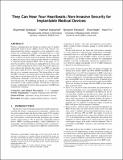| dc.contributor.author | Gollakota, Shyamnath | |
| dc.contributor.author | Hassanieh, Haitham | |
| dc.contributor.author | Ransford, Benjamin | |
| dc.contributor.author | Katabi, Dina | |
| dc.contributor.author | Fu, Kevin | |
| dc.date.accessioned | 2012-09-06T17:54:43Z | |
| dc.date.available | 2012-09-06T17:54:43Z | |
| dc.date.issued | 2011-08 | |
| dc.identifier.isbn | 978-1-4503-0797-0 | |
| dc.identifier.uri | http://hdl.handle.net/1721.1/72549 | |
| dc.description.abstract | Wireless communication has become an intrinsic part of modern implantable medical devices (IMDs). Recent work, however, has demonstrated that wireless connectivity can be exploited to compromise the confidentiality of IMDs' transmitted data or to send unauthorized commands to IMDs---even commands that cause the device to deliver an electric shock to the patient. The key challenge in addressing these attacks stems from the difficulty of modifying or replacing already-implanted IMDs. Thus, in this paper, we explore the feasibility of protecting an implantable device from such attacks without modifying the device itself. We present a physical-layer solution that delegates the security of an IMD to a personal base station called the shield. The shield uses a novel radio design that can act as a jammer-cum-receiver. This design allows it to jam the IMD's messages, preventing others from decoding them while being able to decode them itself. It also allows the shield to jam unauthorized commands---even those that try to alter the shield's own transmissions. We implement our design in a software radio and evaluate it with commercial IMDs. We find that it effectively provides confidentiality for private data and protects the IMD from unauthorized commands. | en_US |
| dc.description.sponsorship | National Science Foundation (U.S.). (Grant number CNS-0831244) | en_US |
| dc.description.sponsorship | National Science Foundation (U.S.). Graduate Research Fellowship Program | en_US |
| dc.description.sponsorship | Alfred P. Sloan Foundation. Fellowship | en_US |
| dc.description.sponsorship | United States. Dept. of Health and Human Services. Cooperative Agreement (90TR0003/01) | en_US |
| dc.language.iso | en_US | |
| dc.publisher | Institute of Electrical and Electronics Engineers (IEEE) | en_US |
| dc.relation.isversionof | http://dx.doi.org/10.1145/2018436.2018438 | en_US |
| dc.rights | Creative Commons Attribution-Noncommercial-Share Alike 3.0 | en_US |
| dc.rights.uri | http://creativecommons.org/licenses/by-nc-sa/3.0/ | en_US |
| dc.source | MIT web domain | en_US |
| dc.title | They Can Hear Your Heartbeats: Non-Invasive Security for Implantable Medical Devices | en_US |
| dc.type | Article | en_US |
| dc.identifier.citation | Shyamnath Gollakota, Haitham Hassanieh, Benjamin Ransford, Dina Katabi, and Kevin Fu. 2011. They can hear your heartbeats: non-invasive security for implantable medical devices. In Proceedings of the ACM SIGCOMM 2011 conference (SIGCOMM '11). ACM, New York, NY, USA, 2-13. | en_US |
| dc.contributor.department | Massachusetts Institute of Technology. Computer Science and Artificial Intelligence Laboratory | en_US |
| dc.contributor.department | Massachusetts Institute of Technology. Department of Electrical Engineering and Computer Science | en_US |
| dc.contributor.approver | Katabi, Dina | |
| dc.contributor.mitauthor | Gollakota, Shyamnath | |
| dc.contributor.mitauthor | Hassanieh, Haitham | |
| dc.contributor.mitauthor | Katabi, Dina | |
| dc.contributor.mitauthor | Fu, Kevin | |
| dc.relation.journal | Proceedings of the ACM SIGCOMM 2011 Conference (SIGCOMM '11) | en_US |
| dc.eprint.version | Author's final manuscript | en_US |
| dc.type.uri | http://purl.org/eprint/type/ConferencePaper | en_US |
| dspace.orderedauthors | Gollakota, Shyamnath; Hassanieh, Haitham; Ransford, Benjamin; Katabi, Dina; Fu, Kevin | en |
| dc.identifier.orcid | https://orcid.org/0000-0002-6689-8189 | |
| dc.identifier.orcid | https://orcid.org/0000-0003-4854-4157 | |
| mit.license | OPEN_ACCESS_POLICY | en_US |
| mit.metadata.status | Complete | |
